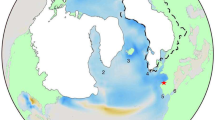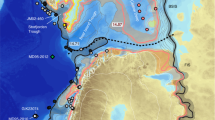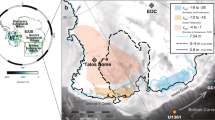Abstract
At the Last Glacial Maximum (LGM), about 21,000 years before present, land-based ice sheets held enough water to reduce global mean sea level by 130 metres1. Yet after decades of study, major uncertainties remain as to the distribution of that ice2. Here we test four reconstructions of North American deglacial ice-sheet history3,4,5,6 by quantitatively connecting them to high-resolution oxygen isotope (δ18O) records from the Gulf of Mexico7,8,9,10,11 using a water mixing model12. For each reconstruction, we route meltwater3,4,5,6 and seasonal runoff13,14,15,16 through the time-evolving Mississippi drainage basin, which co-evolves with ice geometry3,4,5,6 and changing topography as ice loads deform the solid Earth and produce spatially variable sea level in a process known as glacial isostatic adjustment17. The δ18O records show that the Mississippi-drained southern Laurentide ice sheet contributed only 5.4 ± 2.1 metres to global sea level rise, of which 0.66 ± 0.07 metres were released during the meltwater pulse 1A event 14,650–14,310 years before present18, far less water than previously thought5,12,19. In contrast, the three reconstructions based on glacial isostatic adjustment3,4,5 overpredict the δ18O-based post-LGM meltwater volume by a factor of 1.6 to 3.6. The fourth reconstruction6, which is based on ice physics, has a low enough Mississippi-routed meltwater discharge to be consistent with δ18O constraints, but also contains the largest LGM North American ice volume. This suggests that modelling based on ice physics may be the best way of matching isotopic records while also sequestering enough water in the North American ice sheets to match the observed LGM sea level fall1.
This is a preview of subscription content, access via your institution
Access options
Subscribe to this journal
Receive 51 print issues and online access
$199.00 per year
only $3.90 per issue
Buy this article
- Purchase on Springer Link
- Instant access to full article PDF
Prices may be subject to local taxes which are calculated during checkout



Similar content being viewed by others
Change history
30 October 2013
In the print version, a citation to ref. 1 in the first sentence is inadvertently missing; however, the online PDF and HTML versions are correct.
References
Austermann, J., Mitrovica, J. X., Latychev, K. & Milne, G. A. Barbados-based estimate of ice volume at Last Glacial Maximum affected by subducted plate. Nature Geosci. 6, 553–557 (2013)
Carlson, A. E. and Clark, P. U. Ice sheet sources of sea level rise and freshwaterdischarge during the last deglaciation. Rev. Geophys. 50, RG4007 (2012)
Tushingham, A. M. & Peltier, W. R. Ice-3G: a new global model of Late Pleistocene deglaciation based upon geophysical predictions of post-glacial relative sea level change. J. Geophys. Res. 96, 4497–4523 (1991)
Lambeck, K., Yokoyama, Y. & Purcell, T. Into and out of the Last Glacial Maximum: sea-level change during Oxygen Isotope Stages 3 and 2. Quat. Sci. Rev. 21, 343–360 (2002)
Peltier, W. R. Global glacial isostasy and the surface of the ice-age Earth: the ICE-5G (VM2) model and GRACE. Annu. Rev. Earth Planet. Sci. 32, 111–149 (2004)
Gregoire, L. J., Payne, A. J. & Valdes, P. J. Deglacial rapid sea level rises caused by ice-sheet saddle collapses. Nature 487, 219–222 (2012)
Flower, B. P., Hastings, D. W., Hill, H. W. & Quinn, T. M. Phasing of deglacial warming and Laurentide Ice Sheet meltwater in the Gulf of Mexico. Geology 32, 597 (2004)
LoDico, J. M., Flower, B. P. & Quinn, T. M. Subcentennial-scale climatic and hydrologic variability in the Gulf of Mexico during the early Holocene. Paleoceanography 21, PA3015 (2006)
Richey, J., Poore, R., Flower, B. & Quinn, T. 1400 yr multiproxy record of climate variability from the northern Gulf of Mexico. Geology 35, 423–426 (2007)
Williams, C., Flower, B. & Hastings, D. Deglacial abrupt climate change in the Atlantic Warm Pool: a Gulf of Mexico perspective. Paleoceanography 25, PA4221 (2010)
Williams, C., Flower, B. P. & Hastings, D. W. Seasonal Laurentide Ice Sheet melting during the “Mystery Interval” (17.5–14.5 ka). Geology 40, 955–958 (2012)
Carlson, A. E. Geochemical constraints on the Laurentide Ice Sheet contribution to Meltwater Pulse 1A. Quat. Sci. Rev. 28, 1625–1630 (2009)
Xie, P. & Arkin, P. A. Global precipitation: a 17-year monthly analysis based on gauge observations, satellite estimates, and numerical model outputs. Bull. Am. Meteorol. Soc. 78, 2539–2558 (1997)
Liu, Z. et al. Transient simulation of last deglaciation with a new mechanism for Bolling-Allerod warming. Science 325, 310–314 (2009)
He, F. Simulating Transient Climate Evolution of the Last Deglaciation with CCSM3. PhD thesis, Univ. Wisconsin. (2010)
Mu, Q., Zhao, M. & Running, S. W. Improvements to a MODIS global terrestrial evapotranspiration algorithm. Remote Sens. Environ. 115, 1781–1800 (2011)
Kendall, R. A., Mitrovica, J. X. & Milne, G. A. On post-glacial sea level–II. Numerical formulation and comparative results on spherically symmetric models. Geophys. J. Int. 161, 679–706 (2005)
Deschamps, P. et al. Ice-sheet collapse and sea-level rise at the Bølling warming 14,600 years ago. Nature 483, 559–564 (2012)
Aharon, P. Entrainment of meltwaters in hyperpycnal flows during deglaciation superfloods in the Gulf of Mexico. Earth Planet. Sci. Lett. 241, 260–270 (2006)
Mitrovica, J. X. Haskell [1935] revisited. J. Geophys. Res. 101, 555–569 (1996)
Tarasov, L. & Peltier, W. R. A calibrated deglacial drainage chronology for the North American continent: evidence of an Arctic trigger for the Younger Dryas. Quat. Sci. Rev. 25, 659–688 (2006)
Tarasov, L., Dyke, A. S., Neal, R. M. & Peltier, W. A data-calibrated distribution of deglacial chronologies for the North American ice complex from glaciological modeling. Earth Planet. Sci. Lett. 315–316, 30–40 (2012)
Clark, P., Mitrovica, J., Milne, G. & Tamisiea, M. Sea-level fingerprinting as a direct test for the source of global meltwater pulse IA. Science 295, 2438–2441 (2002)
Licciardi, J. M., Teller, J. T. & Clark, P. U. in Mechanisms of Global Climate Change at Millennial Time Scales (eds Clark, U., Webb, S. & Keigwin, D. ) Vol. 112, 177–201 (Geophys. Monogr. 12, AGU, 1999)
Knox, J. C. in Large Rivers: Geomorphology and Management (ed. Gupta, A. ) 145–182 (Wiley, 2007)
Ross, M., Campbell, J. E., Parent, M. & Adams, R. S. Palaeo-ice streams and the subglacial landscape mosaic of the North American mid-continental prairies. Boreas 38, 421–439 (2009)
Teller, J. T. & Leverington, D. W. Glacial Lake Agassiz: a 5000 yr history of change and its relationship to the δ18O record of Greenland. Geol. Soc. Am. Bull. 116, 729–742 (2004)
Whitehouse, P. L., Bentley, M. J. & Le Brocq, A. M. A deglacial model for Antarctica: geological constraints and glaciological modelling as a basis for a new model of Antarctic glacial isostatic adjustment. Quat. Sci. Rev. 32, 1–24 (2012)
Remenda, V. H., Cherry, J. A. & Edwards, T. W. D. Isotopic composition of old ground water from Lake Agassiz: implications for Late Pleistocene climate. Science 266, 1975–1978 (1994)
Hooke, R. L. & Clausen, H. B. Wisconsin and Holocene δ18O variations, Barnes Ice Cap, Canada. Geol. Soc. Am. Bull. 93, 784–789 (1982)
Neteler, M., Bowman, M. H., Landa, M. & Metz, M. GRASS GIS: a multi-purpose open source GIS. Environ. Modelling Software 31, 124–130 (2012)
GRASS Development Team. Geographic Resources Analysis Support System (GRASS GIS) Softwarehttp://grass.osgeo.org/ (Open Source Geospatial Foundation, 2012)
Metz, M., Mitasova, H. & Harmon, R. S. Efficient extraction of drainage networks from massive, radar-based elevation models with least cost path search. Hydrol. Earth Syst. Sci. 15, 667–678 (2011)
Bassett, S. E., Milne, G. A., Mitrovica, J. X. & Clark, P. U. Ice sheet and solid Earth influences on far-field sea-level histories. Quat. Sci. Rev. 309, (2005)
Mitrovica, J. X. & Milne, G. A. On post-glacial sea level: I. General theory. Geophys. J. Int. 154, 253–267 (2003)
Yeager, S. G., Shields, C. A., Large, W. G. & Hack, J. J. The low-resolution CCSM3. J. Clim. 19, 2545–2566 (2006)
Mu, Q., Heinsch, F. A., Zhao, M. & Running, S. W. Development of a global evapotranspiration algorithm based on MODIS and global meteorology data. Remote Sens. Environ. 111, 519–536 (2007)
Kammerer, J. C. Largest Rivers in the United States Open-File Report http://pubs.usgs.gov/of/1987/ofr87-242/ (United States Geological Survey, 1990)
Lemieux, J.-M., Sudicky, E. A., Peltier, W. R. & Tarasov, L. Dynamics of groundwater recharge and seepage over the Canadian landscape during the Wisconsinian glaciation. J. Geophys. Res. 113, 1–18 (2008)
Leventer, A., Williams, D. F. & Kennett, J. P. Dynamics of the Laurentide ice sheet during the last deglaciation: evidence from the Gulf of Mexico. Earth Planet. Sci. Lett. 59, 11–17 (1982)
Waelbroeck, C., Labeyrie, L., Michel, E., Duplessy, J. C. & Mcmanus, J. F. Sea-level and deep water temperature changes derived from benthic foraminifera isotopic records. 21, 295–305 (2002)
Reimer, P. et al. IntCal09 and Marine09 radiocarbon age calibration curves, 0-50,000 years cal BP. Radiocarbon 51, 1111–1150 (2011)
Blaauw, M. Methods and code for ‘classical’ age-modelling of radiocarbon sequences. Quat. Geochron. 5, 512–518 (2010)
Meckler, A. et al. Glacial to Holocene terrigenous organic matter input to sediments from Orca Basin, Gulf of Mexico—a combined optical and biomarker approach. Earth Planet. Sci. Lett. 272, 251–263 (2008)
Wagner, A. J. & Slowey, N. C. Oxygen isotopes in seawater from the Texas-Louisiana Shelf. Bull. Mar. Sci. 87, 1–12 (2011)
Emiliani, C., Rooth, C. & Stipp, J. J. The late Wisconsin flood into the Gulf of Mexico. Earth Planet. Sci. Lett. 41, 159–162 (1978)
Aharon, P. Meltwater flooding events in the Gulf of Mexico revisited: implications for rapid climate changes during the last deglaciation. Paleoceanography 18, 1079 (2003)
Kettner, A. J. & Syvitski, J. P. M. HydroTrend v. 3.0: a climate-driven hydrological transport model that simulates discharge and sediment load leaving a river system. Comput. Geosci. 34, 1170–1183 (2008)
Lamb, M. P. & Mohrig, D. Do hyperpycnal-flow deposits record river-flood dynamics? Geology 37, 1067–1070 (2009)
Marchitto, T. M. & Wei, K. Y. History of Laurentide meltwater flow to the Gulf of Mexico during the last deglaciation, as revealed by reworked calcareous nannofossils. Geology 23, 779 (1995)
Wilcock, P. R. & Crowe, J. C. Surface-based transport model for mixed-size sediment. J. Hydraulic Eng. 129, 120–128 (2003)
Wolman, M. G. & Miller, J. P. Magnitude and frequency of forces in geomorphic processes. J. Geol. 68, 54–74 (1960)
Syvitski, J. & Kettner, A. J. On the flux of water and sediment into the Northern Adriatic Sea. Continental Shelf Res. 27, 296–308 (2007)
Mulder, T. & Syvitski, J. P. M. Turbidity currents generated at river mouths during exceptional discharges to the world oceans. J. Geol. 103, 285–299 (1995)
Mulder, T., Syvitski, J. P., Migeon, S., Faugères, J.-C. & Savoye, B. Marine hyperpycnal flows: initiation, behaviour and related deposits. Mar. Petrol. Geol. 20, 861–882 (2003)
Tarasov, L. & Peltier, W. R. Arctic freshwater forcing of the Younger Dryas cold reversal. Nature 435, 662–665 (2005)
Peltier, W. Rapid climate change and Arctic Ocean freshening. Geology 35, 1147–1148 (2007)
Parsons, J. D., Bush, J. W. M. & Syvitski, J. P. M. Hyperpycnal plume formation from riverine outflows with small sediment concentrations. Sedimentology 48, 465–478 (2001)
Acknowledgements
We thank F. He, B. Otto-Bliesner and Z. Liu for supplying their TraCE-21K general circulation model outputs. The Climate Prediction Center Merged Analysis of Precipitation (CMAP) precipitation data were provided by the NOAA/OAR/ESRL PSD from their website at http://www.esrl.noaa.gov/psd/. A.D.W. was supported by the US Department of Defense through the National Defense Science and Engineering Graduate Fellowship Program, and by the US National Science Foundation Graduate Research Fellowship under grant number DGE 1144083. J.X.M. acknowledges support from the Canadian Institute for Advanced Research and Harvard University.
Author information
Authors and Affiliations
Contributions
A.D.W. built and ran the drainage basin analysis routine, compiled and corrected the δ18O data, performed the data–model comparisons, and interpreted the results. J.X.M. provided the global sea level model outputs and post-processing software. C.W. produced a large part of the δ18O data. R.S.A. assisted with idea development. A.D.W. wrote the manuscript, with input and suggestions from R.S.A., J.X.M. and C.W.
Corresponding author
Ethics declarations
Competing interests
The authors declare no competing financial interests.
Extended data figures and tables
Extended Data Figure 1 Meltwater discharge histories computed from each of the flow-routed ice models.
For comparison, the δ18Oivc-sw data have been converted to meltwater discharge using the mixing model (equation (1)). The negative discharge shown in the data indicates that the LIS was growing from precipitation inputs during the Port Bruce Readvance24, significantly reducing net Mississippi discharge (precipitation minus evapotranspiration, minus ice sheet growth) during that time. The modern mean Mississippi discharge, for reference, is 16,790 m3 s−1 (ref. 38).
Source data
Rights and permissions
About this article
Cite this article
Wickert, A., Mitrovica, J., Williams, C. et al. Gradual demise of a thin southern Laurentide ice sheet recorded by Mississippi drainage. Nature 502, 668–671 (2013). https://doi.org/10.1038/nature12609
Received:
Accepted:
Published:
Issue Date:
DOI: https://doi.org/10.1038/nature12609
This article is cited by
-
Enhanced subglacial discharge from Antarctica during meltwater pulse 1A
Nature Communications (2023)
-
Rapid northern hemisphere ice sheet melting during the penultimate deglaciation
Nature Communications (2022)
-
Extensive wetland development in mid-latitude North America during the Bølling–Allerød
Nature Geoscience (2021)
-
A reconciled solution of Meltwater Pulse 1A sources using sea-level fingerprinting
Nature Communications (2021)
-
The shaping of erosional landscapes by internal dynamics
Nature Reviews Earth & Environment (2020)
Comments
By submitting a comment you agree to abide by our Terms and Community Guidelines. If you find something abusive or that does not comply with our terms or guidelines please flag it as inappropriate.



